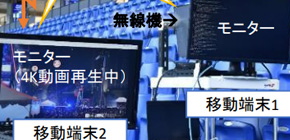
Experiments of 5th generation wireless systems conducted in a large football stadium
Millimeter-wave communication system using radio over fiber
Advanced Photonic Infrastructure for Dense user environments (RAPID) led by Associate Professor Hiroshi MURATA at the Graduate School of Engineering Science, Osaka University, conducted experiments of 5th generation wireless systems (5G) using millimeter-wave (mm-wave) technology at the Suita City Football Stadium (Suita City, Osaka, Capacity: 40,000). These experiments held in a large football stadium, the first of their kind in the world, demonstrated that the mm-wave communication system would be useful in drastically improving communication speeds of smartphones in the future.
In wireless networks of mobile terminals such as those utilized by smartphones, Wi-Fi speeds slow down in dense user environments, which annoys users. Since multiple users use the same band of frequencies in the same space, radio wave interference occurs.
In preparation for the 2020 Tokyo Olympics, 5G, or the next-generation technology of mobile communication networks to allow for comfortable wireless communications even in large athletic fields with hundreds of thousands of spectators is sought after. Mm-waves for 5G are suitable for high-speed communications and can reduce radio wave interference; however, many base station antennas for communications need to be installed. Thus, reducing the cost of antenna stations was a challenge.
The group led by Associate Professor Murata proposed to reduce these costs by using base station antennas as simple remote antennas. They attempted to reduce overall system costs by concentrating the function of processing wireless signals on the central station, which was performed by individual antenna stations, and by sharing the signals with many antenna stations.
Focusing on the features of mm-wave bands, that is, the coverage of mm-wave bands can be easily limited and radio wave interference can be suppressed in mm-wave bands, this group established communication systems by using Radio over Fiber (RoF) technologies, which combine radio waves with optical communication technology, performing their verification experiments.
This group demonstrated that high-speed communications were possible even in a large stadium through the distributed arrangement of antenna stations on the ceiling for the mm-wave communication system. In addition, by using mobile IP technology in order to concurrently use the existing communication infrastructure, they developed a system to automatically switch Wi-Fi, 4G, and mm-wave communication, checking the system’s operation capabilities at the stadium as well.
This group’s research results clarified that 5G communication system was useful in places where many spectators gathered such as a football stadium, an Olympic stadium, and a baseball stadium. It is anticipated that the development of 5G in the Olympics and the World Cup will continue to advance.
Abstract
Photonic-based millimeter-wave communication systems combined with conventional wireless systems have been proposed for application in dense user environments like large football stadiums. By utilizing a narrow beam antenna for millimeter-wave asymmetric links, effective communication channels can be obtained.
Figure 1
Related link
